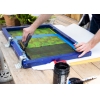|
 Serigraphy is
the printing type when the dye is printed with the help of the mesh made of silk,
cord or any other material which gives the embossed pattern on surface varied
in shape and material. Serigraphy is
the printing type when the dye is printed with the help of the mesh made of silk,
cord or any other material which gives the embossed pattern on surface varied
in shape and material.
In the
present times the art of serigraphy is highly demanded, it is widely practiced
in making logotypes and trading signs on the souvenir items and the patterns
and images are printed on fabric and paper work, plastic or wood. Serigraphy is
good to make visit cards and labels, envelopes and folders, forms and leaflets.
Serigraphy is
the universal printing technology when it allows printing the image of any color
gamut (the number of cells should be equal to the number of colors in the
pattern), on the materials of any type, shape and texture. It is ideal to print
on plastic, paper, cardboard paper, glass, textile and this is not limited.
The art of
serigraphy dates back to the times immemorial. The word «serigrafia» comes from
the Greek «seri» meaning silk and «grafia» which means write or image. And it is
obvious that the initial mesh for serigraphy was made from silk either the
preliminary technology of printing was designed to print on silk tissues only.
And that is why the motherland of serigraphy is believed to be China since silk
production in the country was put in masses 1200 B.C. though, the fact has not
been evidenced materially yet. On the top of it, some scientists suppose the serigraphy
in China
could not origin primarily since silk as the fabric was involved in this
technology in two and a half centuries only.
The
hypothesis is put forward that the mother land of serigraphy is located close
to the Mediterranean Sea, between Mesopotamia and Phoenicia. And even the latter, in
particular, the territory of the modern Lebanon is considered to hold the
right to be the native land for this kind of printing.
The
Phoenicians were famous for their love to sea voyaging, and from
ancient times
the famous navigators and traders come from this country. The ships of
the Phoenicians wouldsail to the Canary Islands and to Great Britain.
The Phoenician merchants would
occupy in trade with the other civilized countries of that time apart
from places
where the dragons existed (the ancient maps had white spots as
unexplored areas
to habituate dragons.
The
Phoenicians were famed for their own manufacture. They were in trouble with the
nature resources though, the trade succeeded to cover all the expenditures. The
natives used to produce the purple as the dye for textile from the gland secretion
of one of the sea shellfishes. Moreover, they invented the technology of
accelerated dying process on the circulated cycle.
The paternity
of the invention is of great doubt, though. There is no data on the equipment
that could perform such technology. By a version, the Phoenicians merchants
would sail to countries where the dragons habituated. And well-developed
civilizations were discovered by them to borrow the technology they mentioned
later. And we are not aware whether the Phoenicians were related to the Atlantis
descendants or to the extraterrestrial civilization. Though there are no marks
of such civilizations apart from some clear coincidences.
There are samples
of technological and cultural accomplishments though, which cannot be correlated
with the level of engineering and technology of those antique times in the
territory of the Mediterranean Sea.
However,
serigraphy is not alone in the unknown nature without any evidenced documents.
We are not aware of the place of birth of this technology; we have no
stereotypes and analogues of what is serigraphy now. Such mysterious accomplishments
include some monuments of the vanished cultures, like pyramids of Maya, drawing
in ancient towns of Maya, remainders of the culture of the native population Taiwan and so
forth.
For instance,
some Maya items and the elements of culture from ancient Taiwan depict
the images of the humanoid creatures in space suits with helmets wearing «space»
boots. And this is interesting that there were antennas on helmets. And the
only thing to suppose is that little green men visited Taiwan and America in old times or the ancient
people had fertile imagination to create the tales and myths.
Serigraphy
is the tale as the strange images by Maya and Taiwan population. The serigraphy s
the technology causes concern from the historian point of view and various
manufactures practice this technology without any concerns.
Moreover,
the latest technology of serigraphy has nothing to do with the preliminary
alien process. The initial system identified the challenges of the unique multiplying
system of repeated patterns.
The technique
of decoration of samurai armour is close to the art of serigraphy that was used
in Japan
within the years of 1185-1333. Therefore, every time when you are about to try
on a T-shirt with a serigraphy print you know it’s like an outfit for an
ancient warrior, though styled to our times.
If you gear
up for somewhat philosophical, you will want to think of the perishable nature of
creature comforts and inevitable transformation from the warrior armours, elite
Japanese warriors to ordinary cotton T-shirts.
|